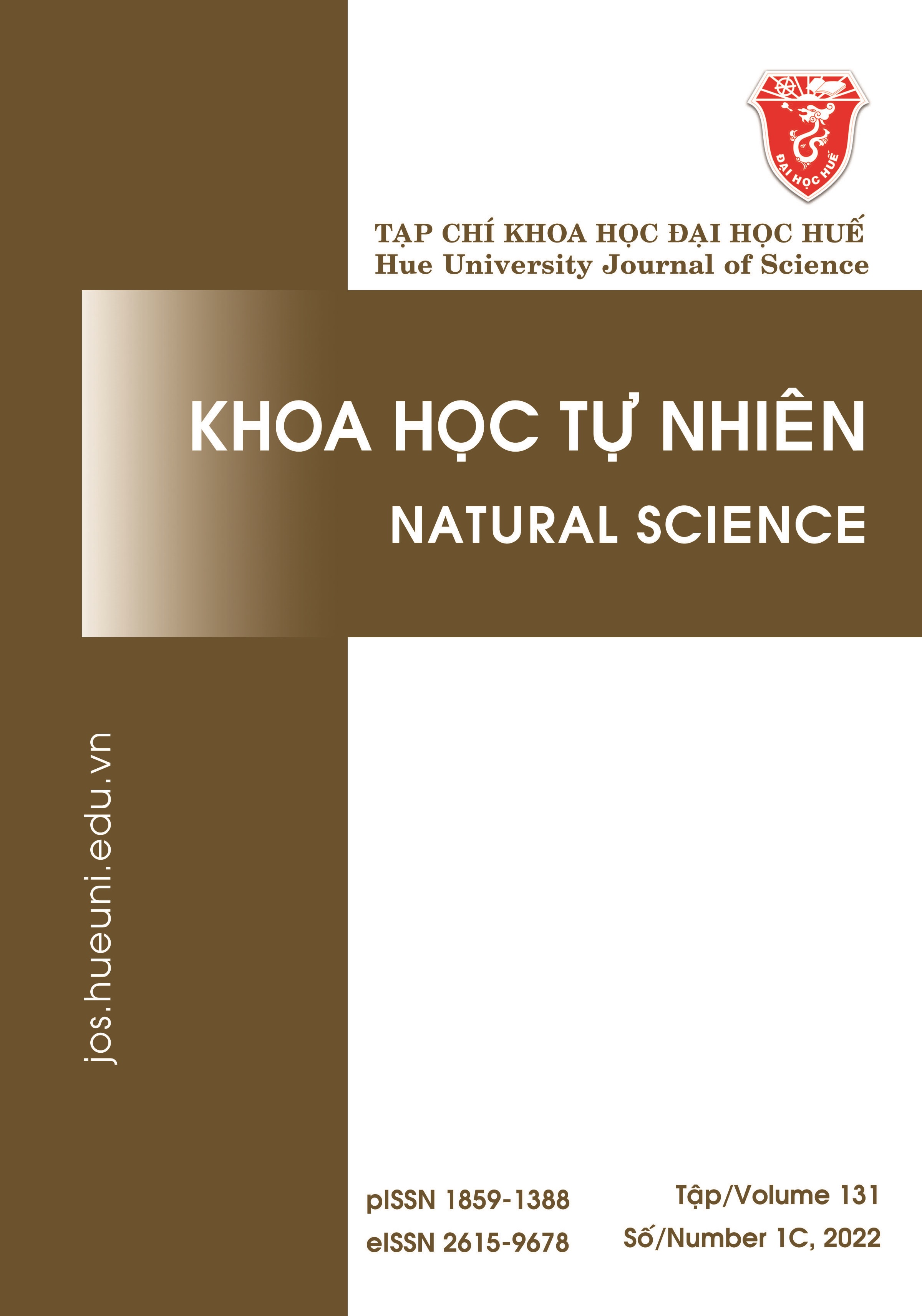Abstract
In this study, we synthesized carbon nanodots (CDs) from mung bean with the hydrothermal method. The average diameter of the CDs is 13.8 nm. The UV-vis absorption spectrum shows a characteristic peak at l = 280 nm, corresponding to the n → p* transition in the C=O bonds. The obtained CDs exhibit a broad emission spectrum ranging from 320 to 460 nm under different excitation wavelengths. Furthermore, by using the comparative method and quinine sulfate as a reference, we obtained a quantum yield of 12.18%. This quantum yield is relatively high compared with that of other precursors.
References
- Zhou J, Sheng Z, Han H, Zoub, M. Li, M. Facile synthesis of fluorescent carbon dots using watermelon peel as a carbon source. Materials Letters. 2012;66(1):222-224.
- Lim SY, Shen W, Gao Z. Carbon quantum dots and their applications. Chemical Society Reviews. 2015, 44(1):362-381.
- Sahu S, Behera B, Maiti TK, Mohapatra S. Simple one-step synthesis of highly luminescent carbon dots from orange juice: application as excellent bio-imaging agents. Chemical Communications. 2012; 48(70):8835-8837.
- Shen P, Gao J, Cong J, Liu J, Li C, Yao J. Synthesis of cellulose-based carbon dots for bioimaging. ChemistrySelect. 2016;1:1314-1317.
- Quang NK, Ha CTC. Low-cost synthesis of carbon nanodots from millets for bioimaging. MRS Advances. 2019;4(3-4):249-254.
- Cao L, Wang X, Meziani MJ, Lu F, Wang H, Luo PG, et al. Carbon dots for multiphoton bioimaging. Journal of the American Chemical Society. 2007; 129(37):11318-11319.
- Baker SN, Baker GA. Luminescent carbon nanodots: emergent nanolights. Angewandte Chemie, International Edition. 2010;38:6726-6744.
- 8Yang Y, Cui J, Zheng M, Hu C, Tan S, Xiao Y, et al. One-step synthesis of amino-functionalized fluorescent carbon nanoparticles by hydrothermal carbonization of chitosan. Chemical Communications. 2012;48:380-382.
- Jumeng W, Xin Z, Yingzhuo S, Jianmin S, Peng H, Shikuan G, et al. Dual functional carbon dots derived from cornflour via a simple one-pot hydrothermal route. Materials Letters. 2014;123: 107-111.
- Jiang C, Wu H, Song X, Ma X, Wang J, Tan M. Presence of photoluminescent carbon dots in Nescafe® original instant coffee: Applications to bioimaging. Talanta. 2014;127:68-74.
- Dong Y, Pang H, Yang HB, Guo C, Shao J, Chi Y, et al. Carbon-based dots co-doped with nitrogen and sulfur for high quantum yield and excitation-independent emission. Angewandte Chemie, International Edition. 2013;52(30):7800-7804.
- Jin X, Sun X, Chen G, Ding L, Li Y, Liu Z, et al. pH-sensitive carbon dots for the visualization of regulation of intracellular pH inside living pathogenic fungal cells. Carbon. 2015;81:388-395.
- Li JY, Liu Y, Shu QW, Liang JM, Zhang F, Chen XP, et al. One-pot hydrothermal synthesis of carbon dots with efficient up- and down-converted photoluminescence for the sensitive detection of morin in a dual-readout assay. Langmuir. 2017;33(4):1043-1050.
- Liu Y, Zhou Q, Yuan Y, Wu Y. Hydrothermal synthesis of fluorescent carbon dots from sodium citrate and polyacrylamide and their highly selective detection of lead and pyrophosphate. Carbon. 2017;115:550-560.
- Sharma V, Saini AK, Mobin SM. Multicolour fluorescent carbon nanoparticle probes for live cell imaging and dual palladium and mercury sensors. Journal of Materials Chemistry B: Materials for Biology and Medicine. 2016;4:2466-2476.
- Ronzio A R, The Encyclopedia of Nutrition and Good Health. New York: Facts on File; 2003. p. 447- 448.
- Peng H and Sejdic JT. Simple aqueous solution route to luminescent carbogenic dots from carbohydrates. Chemistry of Materials. 2009;21:5563-5565
- Allen MW. Measurement of Fluorescence Quantum Yields. Madison: Thermo Fisher Scientific; 2010. Technical Note: 52019.
- Lakowicz JR. Principles of Fluorescence Spectroscopy. New York: Springer; 1999. p. 52-53.
- Zhang M, Ju H, Zhang L, Sun M, Zhou Z, Dai Z, et al. Engineering Iodine-doped carbon dots as dual-modal probes for fluorescence and X-ray CT imaging. International Journal of Nanomedicine. 2015;10:6943-6953.
- Fang Y, Guo S, Li D, Zhu C, Ren W, Dong S, et al. Easy synthesis and imaging applications of cross-linked green fluorescent hollow carbon nanoparticles. ACS Nano. 2012;6(1):400-409.
- Ding H, Li XH, Chen XB, Wei JS, Li XB, Xiong HM. Surface states of carbon dots influences on luminescence. Journal of Applied Physics. 2020 ;127: 231101-231121.
- Liu Y, Zhao Y, Zhang Y. One-step green synthesized fluorescent carbon nanodots from bamboo leaves for copper(II) ion detection. Sensor Actuators B. 2014;196:647-652.
- Zhu S, Meng Q, Wang L, Zhang J, Song Y, Jin H, et al. Highly photoluminescent carbon dots for multicolor patterning, sensors, and bioimaging. Angewandte Chemie, International Edition. 2013;52(14):3953-3957.
- Zhu C, Zhai J, Dong S. Bifunctional fluorescent carbon nanodots: green synthesis via soy milk and application as metal-free electrocatalysts for oxygen reduction. Chemical Communication. 2012;48:9367-9369.
- Vedamalai M, Periasamy AP, Wang CW, Tseng YT, Ho LC, Shiha CC, et al. Carbon nanodots prepared from o-phenylenediamine for sensing of Cu2+ ions in cells. Nanoscale. 2014;6:13119-13125.
- Hsu PC, Chen PC, Ou CM, Changa HY, Chang HT. Extremely high inhibition activity of photoluminescent carbon nanodots toward cancer cells. Journal of Materials Chemistry B. 2013;1:1774-1781.
- Liu H, Ye T, Mao C. Fluorescent cacbon nanoparticles derived from candle soot, Angewandte Chemie, International Edition. 2007;46:6473-6475.
- Sun Y, Wang S, Li C, Luo P, Tao L, Weia Y, et al. Large scale preparation of graphenequantum dots from graphite with tunable fluorescence properties. Physical Chemtry Chemcial Physics. 2013;15:9907-9913.
- Zhao XJ, Zhang WL, Zhou ZQ, Sodium hydroxide-mediated hydrogel of citrus pectin for preparation of fluorescent cacbon dots for bioimaging, Colloids and Surfaces, B: Biointerfaces. 2014;123:493-497.
- Liu S, Tian J, Wang L, Zhang Y, Qin X, Luo Y, et al. Hydrothermal treatment of grass: a low-cost, green route to nitrogen-doped, cacbon-rich, photoluminescent polymer nanodots as an effective fluorescent sensing platform for label-free detection of Cu(ii) ions, Advanced Materials. 2012;24:2037-2041.

This work is licensed under a Creative Commons Attribution-ShareAlike 4.0 International License.
Copyright (c) 2022 Array




